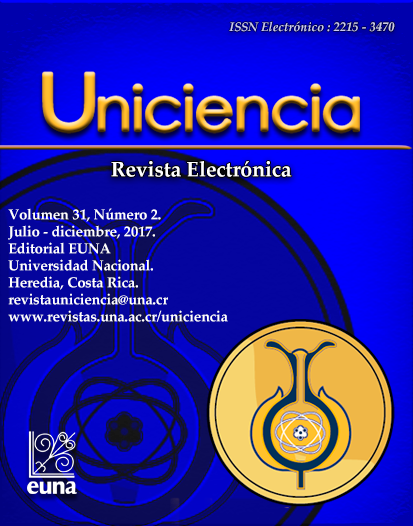Comparison of the Results in the Ambiguity Resolution for a Network of GNSS Stations in Europe Using GPS Data and the Combination with GLONASS Data, Using the Bernese GNSS Processing Software
DOI:
https://doi.org/10.15359/ru.31-2.1Keywords:
Geodesy, Bernese, GPS, GLONASS, ambiguityAbstract
The parameters of the ambiguity in the original observation equations are integer numbers. Technically two procedures are necessary to fix the ambiguities: first, the parameters are estimated as real values; in the second step, they are set to integers. Fixing the ambiguities decreases the number of parameters to be estimated in the final adjustment of the network, taking this result in a reduction in the number of items stored in memory, in the time investing in the processing and an improvement in the quality of the calculate of coordinates. It was made the comparative analysis between the results after processing the network two times: in the first one, only GPS observation was processed; in the second one, both GPS and GLONASS observations were processed. The network used in the project has 25 GNSS stations, located in Europe. The processing was made using the Bernese GNSS software version 5.2. The main conclusion is the importance in the selection of the ambiguity strategy due to is a topic that require an complete analysis, due to the impact that the choose computation method have in the finals results and in the processing time.
References
Bruyninx, C. (2006). Comparing GPS-only with GPS + GLONASS positioning in a regional permanent GNSS network. GPS Solutions, 11(2), 97-106. http://dx.doi.org/10.1007/s10291-006-0041-9
Cioce, V., Robin, A., Mateo, L., & Mackern, V. (2013). Avances en la incorporación de observaciones GLONASS al ajuste de la red SIRGAS-CON [Presentación de Power Point]. Panamá: SIRGAS. 13 diapositivas.
Dach, R., & Walser, P. (2013). Bernese GNSS Software Version 5.2. Course Tutorial. http://www.bernese.unibe.ch/docs/TUTORIAL.pdf
Dach, R., Lutz, S., Walser, P., & Fridez, P. (2015). Bernese GNSS Software Version 5.2. Berna: Publikation Digital AG.
Habrich, H. (2009). H.Drewes (ed.), Geodetic Reference Frames, International Association of Geodesy Symposia 134, DOI 10.1007/978-3-642-00860-3_19, Springer-Verlag Berlin Heidelberg 2009.
Hofmann - Wellenhof, B., Lichtenegger, H., & Wasle, E. (2008). GNSS - Global Navigation Satellite Systems. Austria: Springer-Verlag Wien.
IGS Central Bureau. (8 de abril de 2004). IGS Central Bureau Information System. Recuperado de IGS Central Bureau Information System: http://www.igs.org/overview/viewindex.html
Mervart, L. (1995), Ambiguity Resolution Techniques in Geodetic and Geodynamic Applications of the Global Positioning System. Suiza: Geodätisch-geophysikalische Arbeiten in der Schweiz.
Van-Dam, T., & Ray, R. (2010). S1 and S2 Atmospheric Tide Loading Effects for Geodetic Applications. Data set/Moddel at http://geophy.uni.lu/ggfc-atmosphere/tide-loading-calculator.html
Willis, P., Slater, J., Gurtner, W., Noll, C., Beutler, G., Weber, R., & Hein, G. (1999). The GLONASS IGEX-98 Campaign: From Its Genesis to Its Realization. Tennessee: California Institute of Technology.
Xu, G. (2007). GPS Theory, Algorithms and Applications. Alemania: Springer-Verlag Berlin Heidelberg.
Downloads
Published
Issue
Section
License
Authors who publish with this journal agree to the following terms:
1. Authors guarantee the journal the right to be the first publication of the work as licensed under a Creative Commons Attribution License that allows others to share the work with an acknowledgment of the work's authorship and initial publication in this journal.
2. Authors can set separate additional agreements for non-exclusive distribution of the version of the work published in the journal (eg, place it in an institutional repository or publish it in a book), with an acknowledgment of its initial publication in this journal.
3. The authors have declared to hold all permissions to use the resources they provided in the paper (images, tables, among others) and assume full responsibility for damages to third parties.
4. The opinions expressed in the paper are the exclusive responsibility of the authors and do not necessarily represent the opinion of the editors or the Universidad Nacional.
Uniciencia Journal and all its productions are under Creative Commons Atribución-NoComercial-SinDerivadas 4.0 Unported.
There is neither fee for access nor Article Processing Charge (APC)






